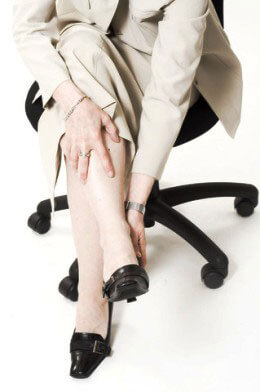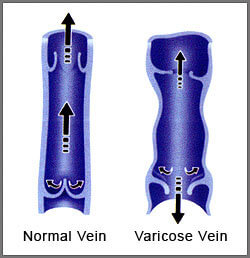Varicose Veins and Treatments
Symptoms
Varicose veins are swollen and usually purple or blue. The blue color is because blood that pools in the veins is deficient of oxygen. Unfortunately, varicose veins don’t improve and usually worsen without treatment. Symptoms and the physical changes of varicose veins come in many forms. Any of these symptoms below can be indicative of venous insufficiency. If left untreated, the symptoms most often worsen and can lead to serious vein disease. Most varicose vein symptoms are worse at the end of the day, around the time of a menstrual period, in hot weather, and with prolonged standing or sitting. Varicose vein symptoms can be painful and are often improved with leg elevation, activity such as walking, the use of compression stockings, or all of the above.
 Swelling is one of the most common varicose vein symptoms. Doctors refer to as “edema”. It usually occurs in the lower part of the leg, usually around the ankle or in the feet. This leg swelling is often more pronounced after longer periods of standing or at the end of the day. Sometimes you may not even notice the swelling, but only see telltale signs, such as an indentation in your ankle from your socks. In other cases, leg swelling may be pronounced and severe. It can also be accompanied by changes in the color of the skin. Swelling often indicates vein problems occurring below the surface of the skin. If your leg swelling involves the tops of your feet, then the swelling could be from a condition we call “lymphedema” which is different from venous insufficiency. Usually people with varicose veins and venous insufficiency have leg swelling that does not extend to their feet.
Swelling is one of the most common varicose vein symptoms. Doctors refer to as “edema”. It usually occurs in the lower part of the leg, usually around the ankle or in the feet. This leg swelling is often more pronounced after longer periods of standing or at the end of the day. Sometimes you may not even notice the swelling, but only see telltale signs, such as an indentation in your ankle from your socks. In other cases, leg swelling may be pronounced and severe. It can also be accompanied by changes in the color of the skin. Swelling often indicates vein problems occurring below the surface of the skin. If your leg swelling involves the tops of your feet, then the swelling could be from a condition we call “lymphedema” which is different from venous insufficiency. Usually people with varicose veins and venous insufficiency have leg swelling that does not extend to their feet.- Indentations from pressure on the leg are another common symptom of varicose veins. Indentations can be caused by socks or even pressing your finger against your leg.
- Itchiness or an irritated rash on or near your veins. This may lead to severely dry skin and can be a form of eczema.
- Numbness over areas where varicose veins are protruding beneath the skin’s surface.
- Throbbing in the legs. This feeling is due to the increased pressure of the blood against the vein wall. Leg throbbing can occur over the entire leg, but is most commonly over areas of large varicose veins or spider veins. It is usually worse after long periods of standing or at the end of a long day. Some patients complain that they have leg throbbing in their feet or calves after exercising for a long time.
- Desire to elevate: Sometimes symptoms of venous insufficiency can by rather subtle. Often, patients express the feeling that they “must” put their feet up at the end of the day. And when they do, they feel a lot of relief. Patients with varicose vein symptoms feel their veins are “under pressure” when they are standing. They also report the leg pressure goes away when their legs are elevated. Although this can be normal, it often indicates a subtle sign of venous insufficiency.
- Worsening varicose vein symptoms during menstruation: In women, varicose veins may be more uncomfortable around the time of the menstrual period, and may worsen after pregnancy. Likely, this is due to hormonal effects on veins.
- Pain: Are varicose veins painful? Varicose veins can often be painful to the touch, especially after a long day of standing. This is due to increased pressure within these fragile veins. Even smaller spider veins can be painful since they often transmit abnormally high pressures from the larger veins. Often, this pain improves considerably with compression stockings.
Causes
 The primary cause of varicose veins are failing vein valves. The failed valves make it more difficult for blood to flow upwards through the veins back to the heart. This condition is called venous insufficiency. Age can also be a factor. As you grow older, the tissue that makes up the vein walls can become less elastic and stretch with pressure. Increased pressure in the leg veins can eventually cause the veins to enlarge, swell, and twist which eventually turn in to varicose veins. Varicose vein treatment addresses the failed valves by utilizing an assortment of treatment methods.
The primary cause of varicose veins are failing vein valves. The failed valves make it more difficult for blood to flow upwards through the veins back to the heart. This condition is called venous insufficiency. Age can also be a factor. As you grow older, the tissue that makes up the vein walls can become less elastic and stretch with pressure. Increased pressure in the leg veins can eventually cause the veins to enlarge, swell, and twist which eventually turn in to varicose veins. Varicose vein treatment addresses the failed valves by utilizing an assortment of treatment methods.
Risks
There are many risk factors that can cause varicose veins. Unfortunately, there is no one factor that can determine if a patient will get varicose veins or not. As a matter of fact, a patient can have all of these risk factors and not get varicose veins. Or a patient could have only one risk factor and get the condition. These factors include:
- Genetics
- Age
- Gender
- Pregnancy
- Lifestyle
- Obesity
- Injury
Diagnosis
We start diagnosis by physical examination. We will check for swelling while standing and then probably perform an ultrasound. Ultrasound is the best diagnostic tool to determine if you have venous insufficiency which is the primary cause of varicose veins. It is a non-invasive and painless procedure that uses sound waves. Ultrasound allows us to observe the characteristics of blood flow to determine if the vein valves are failing. Insurance companies typically cover a consultation and an ultrasound as well as treatment. An ultrasound study is actually one of the requirements most insurance companies require in order for a vein treatment to be covered.
Personalized varicose vein treatment
How are varicose veins removed? There is no “one size fits all” varicose vein treatment. Vein disease is not the same in all individuals and treatments need to be specific for each person. For most patients, we perform a full medical history, examination of the legs, and an ultrasound. We discuss any abnormalities found and then discuss all vein treatment options. Effective varicose veins treatment depends on the patient and the types of veins involved. As a board certified vascular surgeon, Dr Aquino can employ the full array of vein treatments tailored to each individual.
Conservative Treatments
Conservative varicose vein treatment is sometimes sufficient to alleviate symptoms. These are mainly lifestyle changes that may not cure or prevent vein disease. They typically slow disease progress and improve quality of life by dealing with uncomfortable symptoms. Examples of conservative vein treatments are::
- compression stockings or compression therapy
- exercise
- weight loss
- avoiding standing for prolonged periods of time
- leg elevation
- lowering cardiovascular risk factors like LDL cholesterol, blood pressure, and smoking
Endovenous Intervention
When conservative therapy is not enough, Dr. Aquino and her team use non-invasive vein treatments. Compared to venous surgery, these treatments are typically more comfortable for the patient, less costly, require little recovery time, and can be just as effective. These procedures are typically performed in the office. Treating varicose veins rarely requires outpatient surgery in a hospital. Examples of non-invasive treatments are:
Venous Surgery
Sometimes surgery is necessary to treat varicose veins. A well-trained vascular surgeon can provide the best care when surgical intervention is necessary. At the San Francisco Vein Center, we carefully monitor the patient’s well-being before, during, and after surgery.
Varicose veins can be more than cosmetic
Unfortunately, varicose veins don’t improve without treatment. Left untreated, they will usually get bigger and more painful over time. Varicose veins are not just cosmetic, they represent a physical condition caused by insufficient valves and increased pressure in the veins of the legs. Without treatment, the condition typically gets worse including a more noticeable appearance, leg swelling, leg throbbing, leg pain, and the formation of new spider veins or varicose veins. In extreme cases, if the condition continues to be left untreated, venous ulcers can develop which are a serious and can take months to heal.
Contact Dr. Aquino’s office today for your consultation to discover how to control varicose vein appearance and discomfort.
